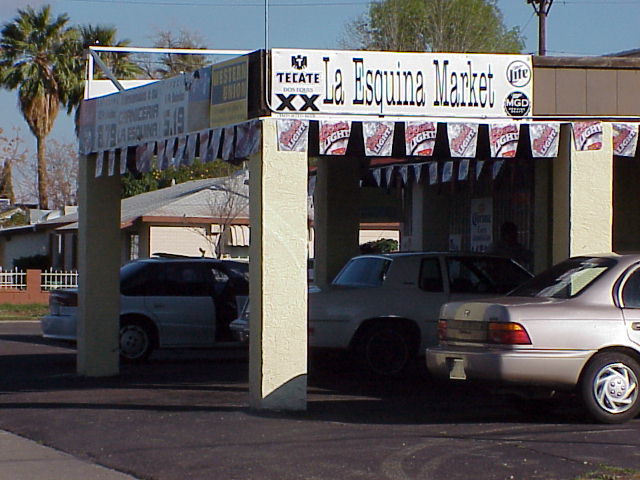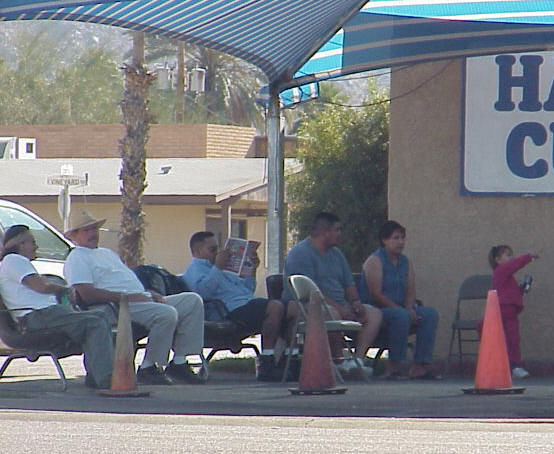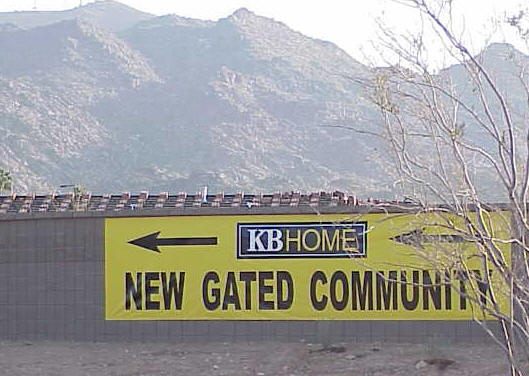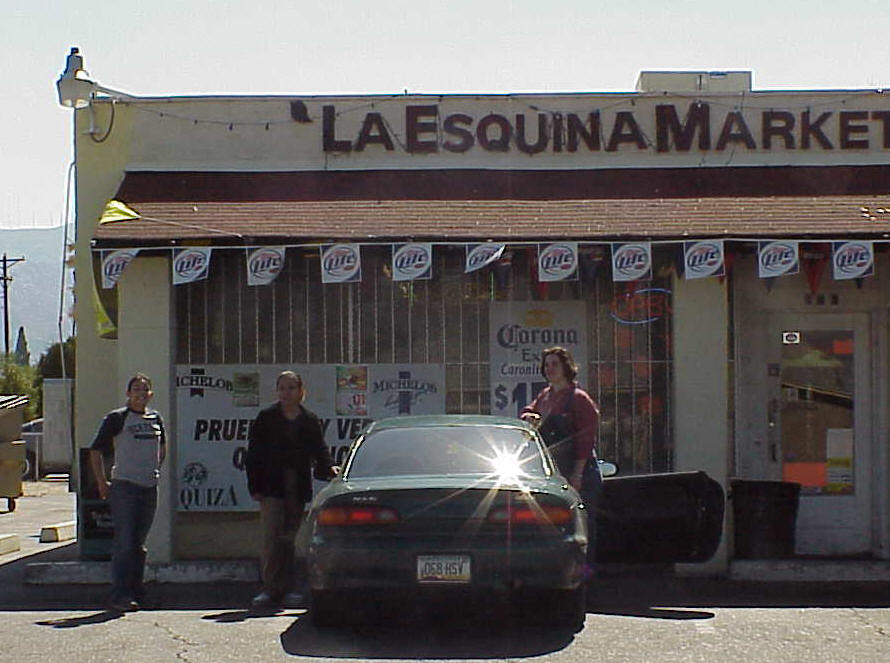In the neighborhood
By: Yolanda Anita Sanchez
Early
in the morning you can stumble from your bed, put on some house shoes, and walk
across the street to purchase your morning
 coffee
in the La Esquina (the corner) market. In the middle of the day, when
you are out of milk to make Mac & Cheese, you can walk to La Esquina market and
purchase milk instead of bother the neighbor. Late at night, when you are
thirsty for a beer and too broke for the bar, you can go next door and buy
libations. (But, you better know how to converse to the store workers and the
other customers in Spanish.) The location of this store really illustrates the
name, convenience store!
coffee
in the La Esquina (the corner) market. In the middle of the day, when
you are out of milk to make Mac & Cheese, you can walk to La Esquina market and
purchase milk instead of bother the neighbor. Late at night, when you are
thirsty for a beer and too broke for the bar, you can go next door and buy
libations. (But, you better know how to converse to the store workers and the
other customers in Spanish.) The location of this store really illustrates the
name, convenience store!
In Phoenix: The History
of a Southwestern Metropolis, Bradford Luckingham explains that South
Phoenix has always contained the poorer residential neighborhoods, and the more
affluent housing areas developed in the northern part of the city. Luckingham
contends that South Phoenix contained “low-rent neighborhoods shunned by
affluent Anglos and left to the Phoenix underclass.” Mexicans and black
residents settled such lower socioeconomic neighborhoods. Mexican immigrants
have continued to migrate over the border and settle in South Phoenix.
Not surprisingly, the
communities in South Phoenix would rise to resemble those in Mexico. Such
markets riddle the neighborhoods of Mexican communities in
Mexico. I am not speaking of a convenience store on the corner of an
intersection or at the end of a street. La Esquina market is in the middle of
the neighborhood, away from any busy street, no where near an intersection.
Besides South Phoenix, where else in
Phoenix can you find a local convenience store in the middle of a neighborhood?
According to James Rojas in “The Latino Use of Urban Space in East Los Angeles”
chapter of Urban Latino Cultures,
 “Latino
residents…can be found on streets, corners, sidewalks, and front yards as well
as in marginal places such as parking lots and alleys.” Such areas, like La
Esquina market, “bring residents together.” The author also contends that in the
mainstream culture, the use of such spaces will actually isolate residents
instead of bring them together (Leclerc). The Latino culture permeates in the
South Phoenix area through markets like this one. Yet, the question remains:
How long will this store, and others like it, stay in the area?
“Latino
residents…can be found on streets, corners, sidewalks, and front yards as well
as in marginal places such as parking lots and alleys.” Such areas, like La
Esquina market, “bring residents together.” The author also contends that in the
mainstream culture, the use of such spaces will actually isolate residents
instead of bring them together (Leclerc). The Latino culture permeates in the
South Phoenix area through markets like this one. Yet, the question remains:
How long will this store, and others like it, stay in the area?
With the gentrification of
South Phoenix now underway, many cultural practices that have dominated the
community seem to be fading with the influx of new residents. In The New
Urban Frontier, Neil Smith describes gentrification as a process where “poor
and working-class neighborhoods in the inner city are refurbished via an influx of private capital
and middle-class homebuyers and renters.” Smith explains that such
neighborhoods have previously suffered from a lack of investment by the city and
private businesses. Using examples in Phoenix,
neighborhoods in the inner city are refurbished via an influx of private capital
and middle-class homebuyers and renters.” Smith explains that such
neighborhoods have previously suffered from a lack of investment by the city and
private businesses. Using examples in Phoenix, the taquierias that once dominated the streets at night have been regulated to
the point of extinction by request of the new community with a different culture
and value system. The new residents are slowly chipping away the culture that
was once prevalent in the community. Smith argues that this type of renewal
“suggests that affected neighborhoods were somehow devitalized or culturally
moribund prior to gentrification.”
the taquierias that once dominated the streets at night have been regulated to
the point of extinction by request of the new community with a different culture
and value system. The new residents are slowly chipping away the culture that
was once prevalent in the community. Smith argues that this type of renewal
“suggests that affected neighborhoods were somehow devitalized or culturally
moribund prior to gentrification.”
Are the days of this
neighborhood market being counted?
 It
has been open for over 20 years; the current owner has had his job for almost 10
years. Residents depend on the convenience and have made the store part of
their everyday routine. Will gentrification close the neighborhood markets?
Only time will tell.
It
has been open for over 20 years; the current owner has had his job for almost 10
years. Residents depend on the convenience and have made the store part of
their everyday routine. Will gentrification close the neighborhood markets?
Only time will tell.
Return to My Home Page
 coffee
in the La Esquina (the corner) market. In the middle of the day, when
you are out of milk to make Mac & Cheese, you can walk to La Esquina market and
purchase milk instead of bother the neighbor. Late at night, when you are
thirsty for a beer and too broke for the bar, you can go next door and buy
libations. (But, you better know how to converse to the store workers and the
other customers in Spanish.) The location of this store really illustrates the
name, convenience store!
coffee
in the La Esquina (the corner) market. In the middle of the day, when
you are out of milk to make Mac & Cheese, you can walk to La Esquina market and
purchase milk instead of bother the neighbor. Late at night, when you are
thirsty for a beer and too broke for the bar, you can go next door and buy
libations. (But, you better know how to converse to the store workers and the
other customers in Spanish.) The location of this store really illustrates the
name, convenience store! “Latino
residents…can be found on streets, corners, sidewalks, and front yards as well
as in marginal places such as parking lots and alleys.” Such areas, like La
Esquina market, “bring residents together.” The author also contends that in the
mainstream culture, the use of such spaces will actually isolate residents
instead of bring them together (Leclerc). The Latino culture permeates in the
South Phoenix area through markets like this one. Yet, the question remains:
How long will this store, and others like it, stay in the area?
“Latino
residents…can be found on streets, corners, sidewalks, and front yards as well
as in marginal places such as parking lots and alleys.” Such areas, like La
Esquina market, “bring residents together.” The author also contends that in the
mainstream culture, the use of such spaces will actually isolate residents
instead of bring them together (Leclerc). The Latino culture permeates in the
South Phoenix area through markets like this one. Yet, the question remains:
How long will this store, and others like it, stay in the area? neighborhoods in the inner city are refurbished via an influx of private capital
and middle-class homebuyers and renters.” Smith explains that such
neighborhoods have previously suffered from a lack of investment by the city and
private businesses. Using examples in Phoenix,
neighborhoods in the inner city are refurbished via an influx of private capital
and middle-class homebuyers and renters.” Smith explains that such
neighborhoods have previously suffered from a lack of investment by the city and
private businesses. Using examples in Phoenix, the taquierias that once dominated the streets at night have been regulated to
the point of extinction by request of the new community with a different culture
and value system. The new residents are slowly chipping away the culture that
was once prevalent in the community. Smith argues that this type of renewal
“suggests that affected neighborhoods were somehow devitalized or culturally
moribund prior to gentrification.”
the taquierias that once dominated the streets at night have been regulated to
the point of extinction by request of the new community with a different culture
and value system. The new residents are slowly chipping away the culture that
was once prevalent in the community. Smith argues that this type of renewal
“suggests that affected neighborhoods were somehow devitalized or culturally
moribund prior to gentrification.”  It
has been open for over 20 years; the current owner has had his job for almost 10
years. Residents depend on the convenience and have made the store part of
their everyday routine. Will gentrification close the neighborhood markets?
Only time will tell.
It
has been open for over 20 years; the current owner has had his job for almost 10
years. Residents depend on the convenience and have made the store part of
their everyday routine. Will gentrification close the neighborhood markets?
Only time will tell.